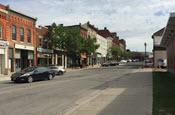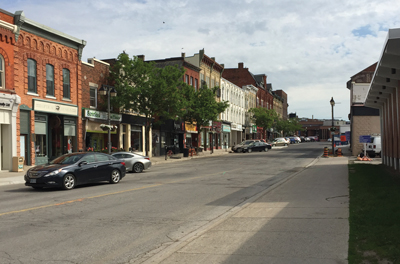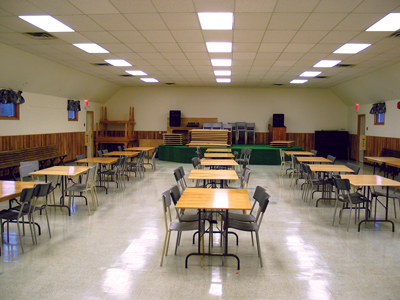
Planners, farm leaders and educators discuss ways to revive these community anchors and places of social engagement during turbulent times.
by Kate Ayers
Farm life is known for its strong ties to and close relations with neighbours, friends, and colleagues.
The open doors of local legions, churches and recreational centres over the last century all contributed to this sense of community. However, because of COVID-19 and an increasing dependence on social distancing and digital communication, what will come of in-person community interaction?
While it has been a long-standing issue, the pandemic has shed light on the loss of rural third places – where people can spark up conversations with whomever they meet.
Such places also provide space for intergenerational groups to host meetings and activities.
The needs of residents have shifted compared to 50 to 70 years ago when many third places were built, but these locations still serve valuable functions in rural areas.
“Third places have always been a significant element of rural communities. They are sites of celebrations and friendships. They really are the social fabric that knits rural communities together,” says Dr. Ryan Gibson.

“However, sometimes we forget that these places are there and contribute to the long-term prosperity and vibrancy of communities. They have always been in our backyards.”
Gibson is the Libro professor in regional economic development for southwestern Ontario at the University of Guelph. The professorship is a partnership between Libro Credit Union and the university’s Ontario Agricultural College, focused on building economic development and innovation across the region, through world-class research, teaching, outreach and collaboration.
This month, Better Farming speaks with Gibson, farmers, municipal representatives, and other stakeholders to learn about the benefits that third places provide to constituents, the challenges such establishments face, and how communities can revive these important landmarks.
What are third places?
The name “third places” suggests that two places come before.
In this model, homes are considered “first” places and workplaces are “second.” Third places are for social engagement and contribute to the strength of communities.
For farm families, first places act as both their homes and places of work. COVID-19 has further eliminated the need for and use of second places. Combine this situation with the rapid decline of third places, and rural residents are left with few options for social interactions outside of their households.
“In cities, these spaces may be the coffee shop, gym or yoga class,” says Jennifer Miltenburg, a dairy farmer and director of Kingsbridge Centre in Huron County. Kingsbridge is a repurposed church that was formerly closed. Through the work of volunteers, the building now serves as a multi-use facility that provides an affordable space for seniors, youth and community use.
In rural communities, third places are typically churches and community halls where residents can host local organized events and sporting activities, Pam Duesling says. She’s a sixth-generation farmer in Norfolk County and general manager of development services in the County of Brant.
Indeed, third places serve economical, social, cultural and environmental functions, Gibson says.
“They are sites of social engagement and are hubs for sharing information, local events, news and activities,” he adds.
Third places “make people feel connected to and embedded in the community. They truly are agents of community building.”
In fact, studies show that people want third places close to where they live to boost quality of life, Gibson says.
Perhaps the most important aspect of third places is that they “are open, regardless of social or economic status. And they are accessible whether you drive, bike or walk,” Gibson says.
Third places are social levellers and are shown to promote unity among individuals with diverse ethnic origins, backgrounds, perspectives, and experiences.
Benefits
Third places “make a community a community,” Duesling says.
These places “are especially important in rural communities where there can be geographic isolation, limited financial support to assist in the upkeep of facilities and limited volunteer efforts to organize arts, sports and leisure activities.”
Rural residents use these places “to socialize, learn and have fun. They are also the places that can generate money through fundraisers for community projects and youth.
“For example, residents can use community halls as venues for social events, 4-H clubs, hunting courses, babysitting courses, pre-teen dances, and Lions and Lioness Club meetings.
“Youth can congregate to play hockey and ringette, or figure skate at local arenas and parents come to support their children and socialize. Local libraries are where youth can learn to read through organized programs and the elderly can meet for book clubs, tea, knitting classes, etc.,” Duesling says.

Third places are often affordable options for events and recreational activities because they are financed by municipalities or local volunteer organizations.
“We are dedicated to giving back to our community by offering nearfree rental space for events,” says Jamie Reaume, the CEO at Country Heritage Park in Milton.
“We want the community to be the centrepiece of what we do.”
Third places are spaces where volunteers and other members work to maintain or repair social fabrics, he says.
Intergenerational interaction is important in communities. Third places foster connections between younger and older generations and mentorship can be a product of such interactions.
In these situations, “someone older shares their knowledge and wisdom with someone younger, which provides beneficial interactions for both people, such as value and community connection,” Miltenburg says.
“Younger generations learn to value older ones. They also want to help others and themselves.
“People care more about each other when they have connections with one another. These friendships benefit the physical and mental health of societies.
“But if people do not have a space where they can physically see others, making those connections is hard,” she says.
Challenges
Third places and their dedicated members face logistical and financial challenges maintaining these spaces for the public. Many of these facilities were in disrepair before COVID-19, and the pandemic has taken a toll on community spaces.
“Keeping these local facilities in financial standing is challenging as rural municipalities simply cannot afford to maintain various old buildings. Many third places need many improvements to abide by Ontario Building Code or Fire Code regulations,” Duesling says.
“These buildings are also utilized less in rural areas” than they were in the past because now “many parents both work, and fewer adults have time to volunteer to organize events and activities.”
Unreliable Internet connections also present a significant hurdle.
“Many rural communities are underserved by federal standards in regard to Internet” access, Miltenburg says.
“If rural communities do not have a primary business or organization that will use a lot of Internet to pay for the infrastructure, tech companies are not interested in running miles of fibre optic cable and connecting towers for 100 customers.
“So, how do you get the word out to a broader audience? Settlement areas that were once towns, now do not have any grocery stores, schools or banks. These areas do not have a central location to advertise or network. We are constantly reinventing the wheel,” she says.
As a result, we must “find funding sources from within our small communities because we can’t get the word out to anyone else. This reality takes a toll on finances.”
Without third places and connectivity, residents could begin to feel isolated and lonely. These factors are directly linked to an individual’s mental and physical health, Miltenburg says.
Sandra Weber, director of Huron County’s planning and development department, agrees.
“The lack of reliable Internet in many rural communities exacerbates the impact of the loss of third spaces. The loss of fellowship opportunities – whether they occur in an arena, church, coffee shop, or library – has been perceived as one of the most significant impacts by one of our rural communities,” she says.
“Many COVID-19 coping strategies rely on the ability to connect online. This accessibility is a challenge in areas without reliable Internet.”
Indeed, the societal costs of losing third places may be far greater than the financial costs to maintain or update these establishments.
Feelings of “connection to place and community start to disappear as third place options decline,” Gibson points out.
The loss of neighbourly relations and social and communication skills could lead to further loss of rural roots and agricultural history, Duesling says.
“Will my grandchildren know what a church is? The building that has historically been the cornerstone of socialization in rural areas?” she asks.
In addition, community as the centre of third places makes it hard for these establishments to operate during a time of social distancing and stay-at-home orders.
“We are a public-oriented association and not having the public is crippling. Economically, it has been really hard,” Reaume says.
Repurpose and revitalize
Fortunately, challenges present opportunities for improvement and growth. Strategies do exist that might help rural communities revive their third places.
Perhaps the first step in revitalization is to recognize the value of these places and the implications of their loss in communities, Gibson says.
“We often forget about third places day-to-day and just assume that they will always be there” and when these buildings close, we may not “notice until weeks, months or years later. But by then, it’s too late,” he says.
Miltenburg agrees.
“People in leadership positions need to recognize the need for these places because the people who take care of these spaces are busy trying to maintain social fabrics and run programs with fewer volunteers,” she says.
Program facilitators often “do not have the time nor resources to set up succession frameworks or plan for the future.”
Municipality representatives should be involved, Miltenburg says.
A “community liaison or developer can help groups work together. If you have an external mediator who does not have a vested interest in any individual site, but only in the fight as a whole, people trust the project lead a lot more than a community representative. Multiple communities are more willing to work together,” Miltenburg explains.
And everyone needs to be on board.
“You cannot make a community hub with one or two strong leaders. You need the community to want it. Maintaining third places is a lot of work and non-profit models can’t support building revitalization without many volunteers.”
During initial planning, a multi-purpose perspective could change how communities use third places and serve more residents.
“When these places were established, planners had a specific focus in mind. I think we need to increasingly look at how to use these places for multiple purposes. For example, the community centre could be made available in the evenings for activities, but maybe daycare staff could utilize that space during the day,” Gibson says.
“The more we can envision these spaces with multiple groups and purposes, I think it will allow us to reinvigorate them and to justify the financial and time commitments of reviving these spaces.”
In addition, both the people “who live in communities and their needs have changed over the years,” Gibson says. “So, there are opportunities to think outside the box as we start to consider reviving these places and how we govern them. We must make sure the spaces are inclusive and accessible.”
“The time to act was yesterday,” Miltenburg says.
“If the building is still open, now is the time to motivate community members and network with those who want to be a part of a project of this scope. Once the building is gone, you lose those connections. People will find another third place or will just retreat into themselves because it’s easier to sit at home than be involved. Every year you wait makes the job that much harder.” BF



Post new comment